Drew Smith
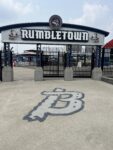
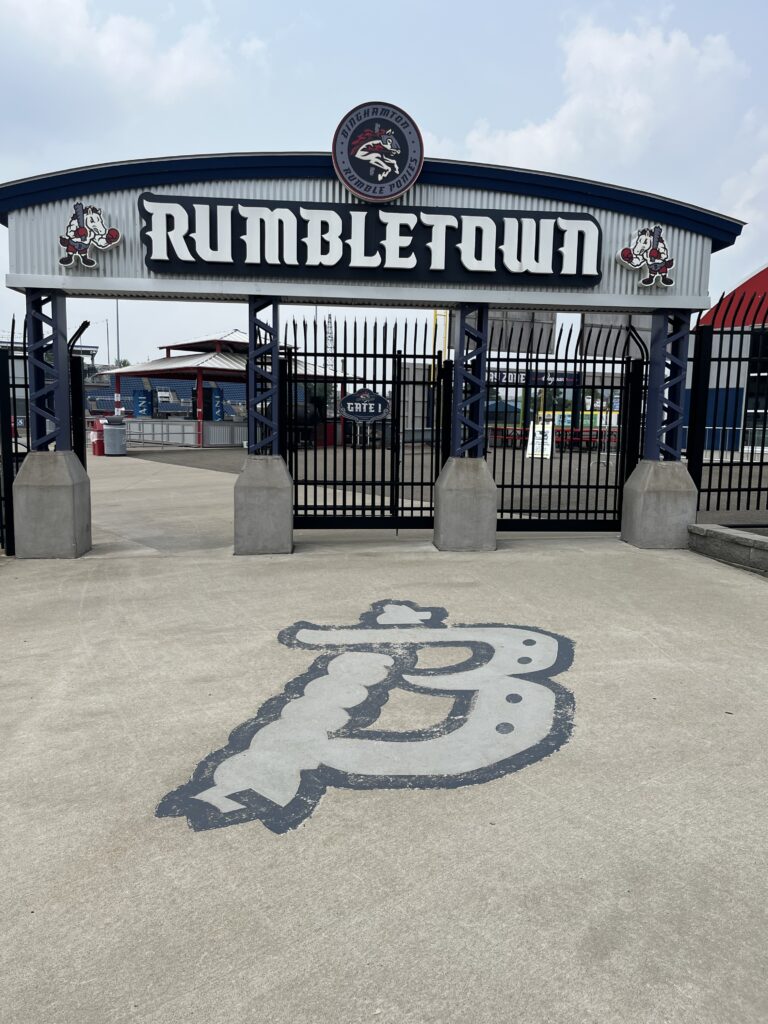
Being a hockey dad means you’re traveling a lot and going/passing through places you may not normally travel. While you may be tired and want to go home after a tournament, sometimes it’s well worth making stops along the way.
Being the avid New York Mets fan I am, my family opted to stop in Binghamton. It made sense as a stop to stretch, eat, and of course, take in Mirabito Stadium.
One thing to know right off the bat is it’s pronounced MER-AH-BIT-TO. A local quickly corrected me when I mispronounced it.
More importantly, the ballpark is open everyday. I found that out when I mentioned to a security guard that I owned this site and was an editor at MMN and I was hoping to walk around the park. His response was, “Okay, well, everyone can walk around as long as they stay off the field.”
Right off the bat, the ballpark has that minor league feel we lose somewhat with the Brooklyn Cyclones. There’s not a bad seat in the house, and you’re right there for all of the action.
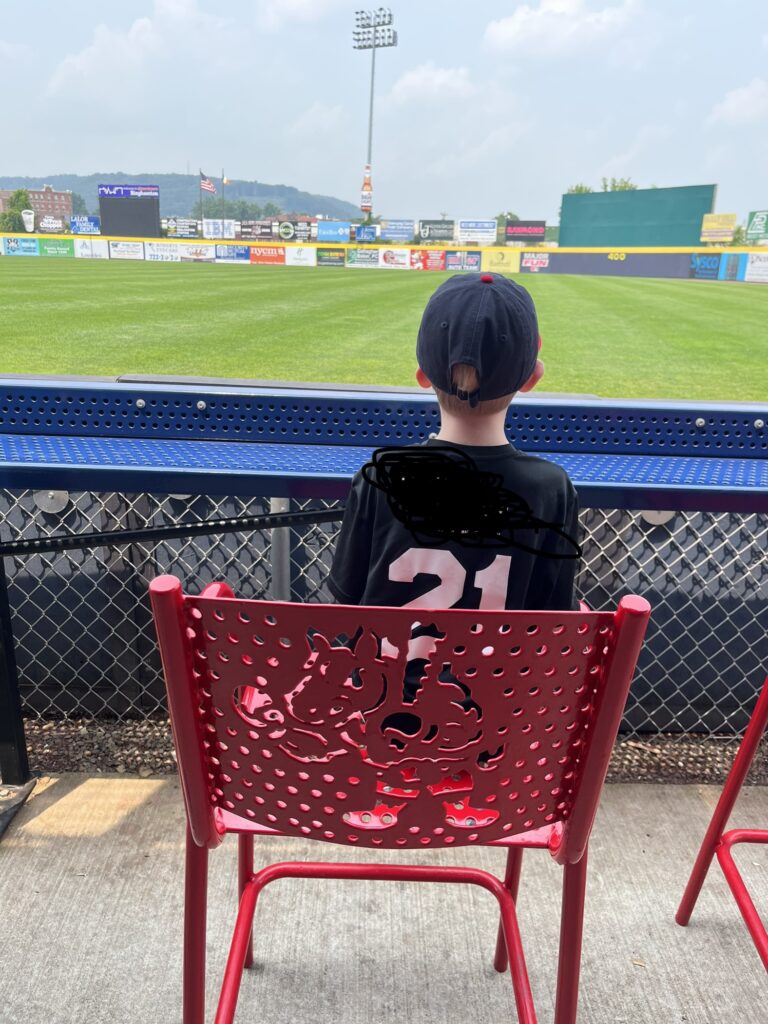
Rowdy the Rumble Pony on the outfield high top chairs was a nice touch. A nice touch describes much of the ballpark which embraces its own history as well as their affiliation with the Mets.
The bullpen carries the monitor “The Road to Queens Runs through Rumbletown.” That was certainly true for current Mets pitchers Grant Hartwig, David Peterson, and Drew Smith. It may also hold true for current Rumble Ponies like Christian Scott and Dominic Hamel.
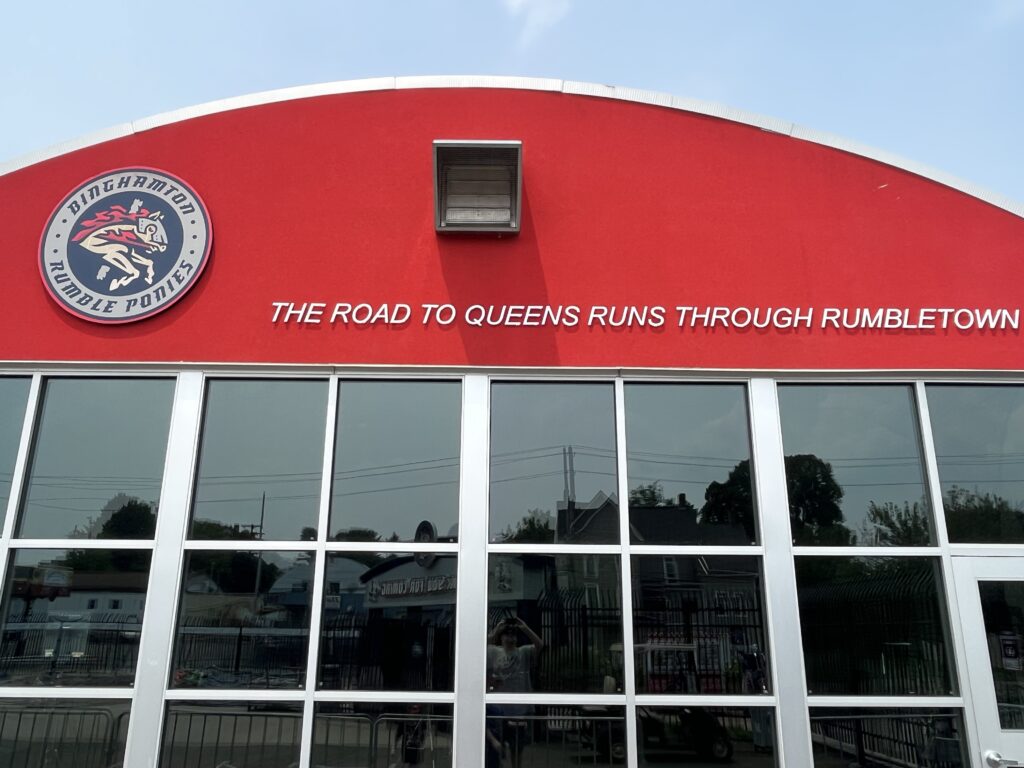
In terms of the history, Binghamton has a “Binghamton Baseball Shrine” honoring all the Binghamton players of yesteryear. It’s there you are reminded Binghamton hasn’t always been a Mets affiliate.
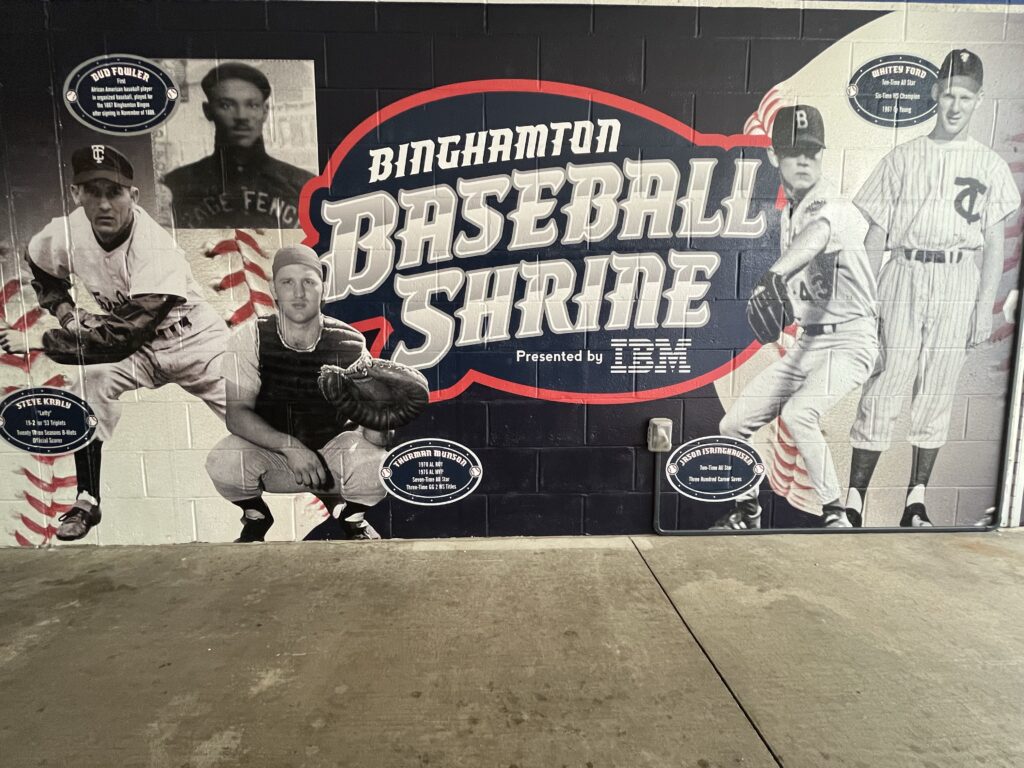
As you can see, most of the players were before the Mets even existed. You see names like Whitey Ford and Thurmon Munson. You can see the Mets feel and acknowledgement with Jason Isringhausen on the far right.
For those wondering where David Wright is, don’t worry, he’s there. He just couldn’t make the main image and is instead off to the side on the door.
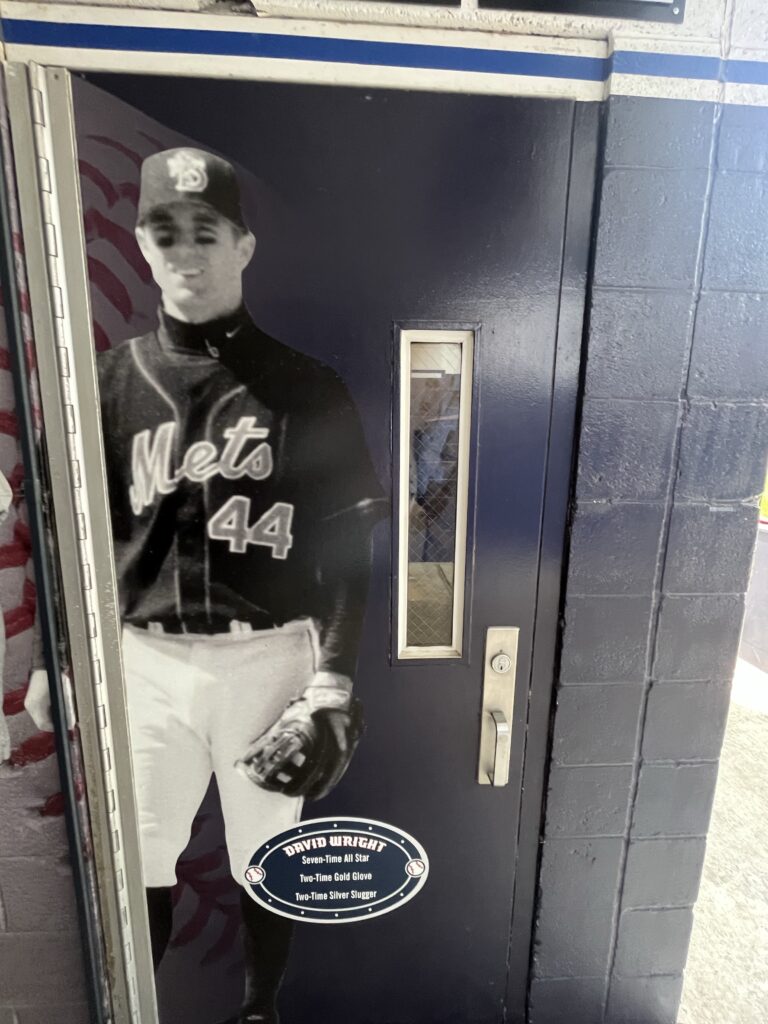
As odd as it was seeing him off to the side, it was even stranger seeing him with the number 44. For those that remember, Wright wanted to wear 4 (he didn’t ask for it) until Charlie Samuel decided Wright should wear 5 for Brooks Robinson and George Brett.
Shockingly, Samuel didn’t remember Robin Ventura of Grand Slam Single Fame. But, I digress.
Unfortunately, the Baseball Shrine is out of the main view, but it is en route to the gift shop. On the way, you will also see things like the lineups and league leaders (Eastern League and MLB).
The gift shop has what you’re really looking for with hats, jerseys, cards, and of course, stuffed animal mascots. You can get the jerseys personalized (but not t-shirts). It’s all reasonably priced with discounted winter items. I walked away with a cap.
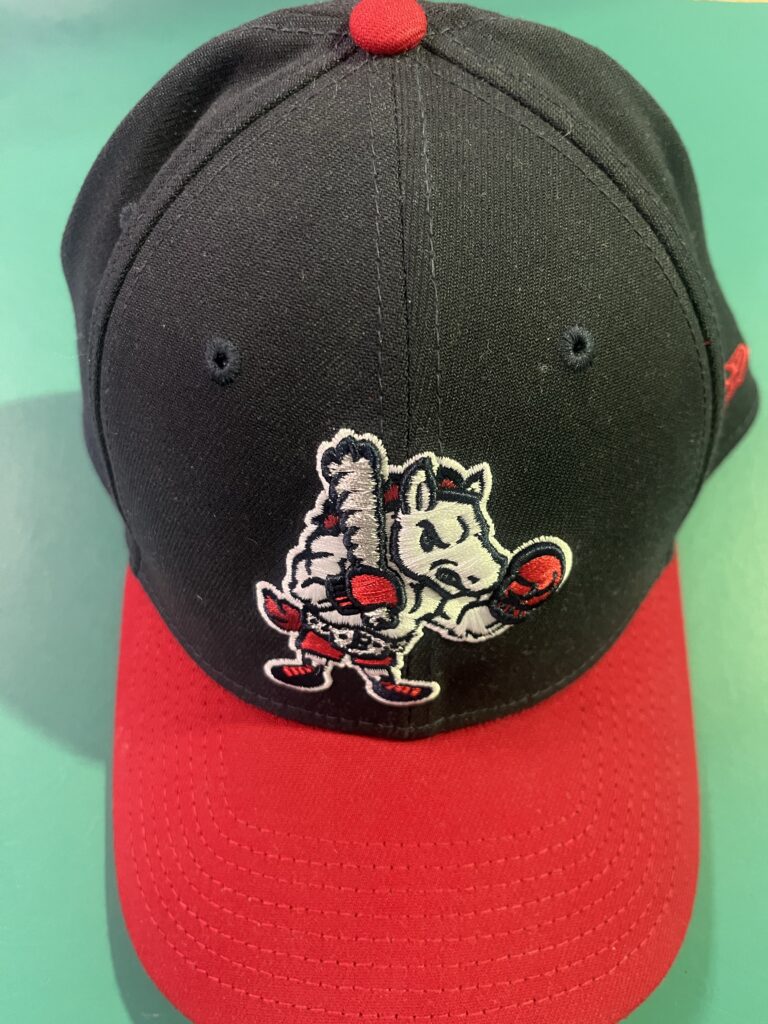
The only downside of the trip to the ballpark was it was not a game day. That said, the staff was great, and my kids had a blast running through the park. Certainly, there will be a trip back to Binghamton to catch a game or two.
For the second time this season, a New York Mets pitcher was thrown out of a game for having an illegal substance on their hands. Both times, there was an MLB official involved.
With Max Scherzer, he was told to clean his hands because of the rosin residue. He would wash his hands in the presence of an MLB official. When Scherzer returned to the game, he would be thrown out for having an illegal stick substance on his hand.
What was interesting with Scherzer was David Cone did an experiment on Sunday Night Baseball which effectively exonerated Scherzer. In essence, he showed how what Scherzer claimed was absolutely true, and yet, Scherzer was still suspended.
In the opener of the Subway Series, the umpires did a check of Drew Smith before the top of the seventh. Umpire Bill Miller determined Smith’s hands were too sticky and ejected him from the game. After the game, Miller would say he didn’t know what the substance was, just that Smith’s hands were too sticky.
Ron Darling was frustrated asking for a standard to be put in place. This might be more fantasy than reality. It’s really difficult to adopt a uniform standard, and that is part of the shortsightedness of MLB implementing this rule.
However, that’s not the most troubling part of all of this. The most troubling part is an MLB official did not find Smith’s hands sticky in a post-ejection inspection.
Drew Smith says he had an MLB official check his hands in the tunnel after his ejection.
He says the official laughed and said there was "nothing there." pic.twitter.com/Vc1AfdCxA3
— SNY (@SNYtv) June 14, 2023
Now, there is the caveat here that either Smith or the MLB official was not exactly being truthful. That said, it is alarming Smith was told there was nothing there after he was ejected. If the timeline of events are correct, Smith would not have even had an opportunity to clean his hands before this post-ejection suspension.
With Scherzer, an MLB official supervised and approved the hand washing. With Smith, an MLB official said there was nothing on Smith’s hands.
Of course, the obvious point here is that there is an MLB official right there. Why is that official not performing these substance checks?
The MLB official has the opportunity to see if there is anything illicit happening. The MLB official can easily check hands before or after an inning without any of the theater we see now. For a league hyper focused on pace of play, it would also make the game move just that much quicker.
We can also get more checks with that official able to do it each and every inning. Yes, that would also mean a need for an official in the bullpen. With Major League Baseball having record revenues that should not be an issue at all.
The end result would be the promise of a more unified standard for ballparks because you get the same person checking every time, and that person can be trained specifically for this one area. You also get more testing resulting in the appearance of a fairer game with less foreign substances. Moreover, you get the game moving slightly quicker by ending the umpires periodic checks.
Really, there is no reason why this isn’t happening. At a minimum, you take away the ability for players to claim the MLB official cleared them creating less drama and frustration with the sport. Overall, you’re just making the game better.
When we discuss the New York Mets bullpen, it always need the caveat that the Mets are without Edwin Díaz. Naturally, not having the best closer in baseball is going to severely impact your bullpen and how it is constructed.
For example, David Robertson was signed to be the eighth inning set-up man. That means he steps up to closer with everyone filling in behind him. That naturally weakens the bullpen even with Robertson being almost as good as Díaz was last season.
Now, if the Mets had Robertson and Díaz, they would have the 8th and 9th innings completely locked down. However, they would still have issues with the earlier innings. That was always going to be the place, but for some reason, that was always going to be the plan.
The Mets are suffering from that plan. Putting aside the plan, here are who the Mets key set-up relievers were supposed to be, and here is how they are performing this season:
- Adam Ottavino 0-2, 4.38 ERA, 96 ERA+, 4.79 FIP
- Brooks Raley 1-1, 3.10 ERA, 136 ERA+, 4.52 FIP
- Drew Smith 3-2, 3.74 ERA, 112 ERA+, 4.03 FIP
Raley and Smith have been alright, but they have not been dominant. Ottavino has struggled. What is really concerning with this trio is when you look at their FIP, they are over performing how they are pitching. The last thing the Mets can afford is any of them to regress, and from the looks of it, all of them are due for a regression.
Past them, it’s been a revolving door of relievers. The flavor of the week is Jeff Brigham and Dominic Leone. Previously, it was Jimmy Yacabonis, Denyi Reyes, Dennis Santana, John Curtiss, etc. The only conclusion to be drawn from these names is Billy Eppler and the Mets purposefully opted for relievers who can go back-and-forth instead of one or two more established arms.
The end result of all of this is a bad Mets bullpen. Their 4.17 bullpen ERA is 10th worst in the majors and fifth worst in the NL. The 4.51 FIP is sixth worst overall and third worst in the NL. Overall, the bullpen is just plain bad even with Robertson being dominant.
It needs to be reiterated the Carlos Correa deal fell through. That left the Mets with money to spend on the bullpen, and they didn’t. They instead wanted to go with a bunch of journeymen like Tommy Hunter. Again, this was the plan.
With that being the plan, we should not be surprised the bullpen has not been good. Chances are, it will get worse, at least from what we see with the team FIP. While the Mets didn’t plan on this being the case, that is the end result of their plan, and frankly, they should not be surprised by these results.
Back when the New York Mets acquired Daniel Vogelbach, early analysis on this site was it hurt the Mets in the short-term. It was also noted as a bizarre trade as the Mets in-house options were more than capable of handling the duties the Mets were seeking Vogelbach to handle.
As we have become further removed from the trade, we see it is a trade which has continued to hamper the Mets.
This is not to say Vogelbach has been bad. In fact, Vogelbach has been better with the Mets than he has at any spot in his career posting a 130 OPS+ with the Mets.
That may be news to some Mets fans as they have become frustrated with the designated hitter. They will point to his numbers with RISP (.200/.455/.200) and his lack of power. While productive as a DH, Vogelbach is not the classic power hitter you expect from the position, or frankly, someone with his physique.
That is very noticeable when Mark Vientos is raking in Triple-A. So far this season, Vientos is hitting .331/.416/.677 with 11 2B, 12 HR, and 35 RBI. By every measure, Vientos should be in the majors.
However, he isn’t, and it is inextricably linked to Vogelbach. Yes, fans are frustrated with him, but he has been productive at the plate. As a result, the team is not going to have Vientos join the club to sit.
This is a consideration Billy Eppler should have had last year and this past offseason. Keep in mind, Vientos was raking with Syracuse last season, but the Mets outright refused to give him a look at DH. Instead, they opted for the Vogelbach/Darin Ruf tandem at the trade deadline.
Vientos did not succeed in a short-side platoon in September. This is a reason not to call him up now no matter how much he hits. Arguably, he’s the Mets best DH option now (and probably was last season), but he’s blocked due to the veteran forward approach of Eppler and Buck Showalter.
The trade is made worse by Colin Holderman‘s success with the Pittsburgh Pirates. So far this season, Holderman is 0-1 with a 2.81 ERA, 1.313 WHIP, 2.3 BB/9, and a 10.7 K/9. He has established himself as a very good late inning relief option.
The Mets could use Holderman now, especially after the Edwin Díaz injury. At the moment, David Robertson, Drew Smith, and Adam Ottavino have been the only real reliable relievers so far this season. Past them, the Mets have been cycling through injured relievers and hoping for one or two good outings from the Jimmy Yacabonis and Dennis Santana of the world before they hit the IL or are designated for assignment.
Of course, the there is also the matter of how the Holderman for Vogelbach trade led to the Mychal Givens trade last season. Therein lies the real issues with the Vogelbach trade.
The value of Holderman for Vogelbach was fine. In fact, it might’ve been an underpay for the Mets. However, that trade has forced the Mets into many bad and short-sighted decisions. As a result, we see Vientos stuck in Triple-A, and the Mets still seeking power and production from players who were never going to provide it – players like Vogelbach.
Right now, the New York Mets are 17-18. They’re under .500. As Bill Parcells has been credited with saying, “You are what your record says you are.” Well, that means the Mets are not a good team.
There are caveats we can throw out there, and to be fair, they should be noted.
We saw José Quintana and Justin Verlander start the year on the IL. Carlos Carrasco is on the IL. Max Scherzer didn’t hit the IL, but he was having some issues before the suspension.
Losing four starters like that takes a toll on your rotation and team. Of course, that is a complication of having the oldest rotation in the majors. As oft noted this offseason, rotations this old usually do not make it to the postseason.
The bullpen was thrown a bit into chaos with the unexpected season ending injury to Edwin Díaz. To be fair, the Mets were prepared for that with the addition of David Robertson. The problem is no one outside Robertson and Drew Smith have been very good in the bullpen.
Of course, that is a function of the rotation not going deep into games. That is going to tax the bullpen. However, it is also a function of Billy Eppler not building a complete bullpen over the winter. The bullpen needed 1-2 more arms, and he never got them. He also never replaced Trevor Williams as the long man, which only exacerbates the starting pitching being unable to go deep into games.
Maybe the Mets could weather this storm with more offense, but the offense was left unaddressed in the offseason. The world knew the Mets needed more power in the lineup, and their only attempt was the failed Carlos Correa signing. As a result, the Mets went right back to the lineup which failed against the Atlanta Braves in September and then failed again in the NL Wild Card Series.
The Mets did call up Brett Baty, and he has been good. Francisco Álvarez was put on ice after the Omar Narváez injury, and he has started hitting pretty well. Over the past 13 games, he is hitting .286/.342/.429. These are competent bats right now that are not yet lighting the world on fire.
Of course, that also means they’re some of the Mets more productive bats. You wouldn’t know that because Buck Showalter thinks they belong in the bottom half to bottom third of the lineup. Starling Marte and his 68 wRC+ is permanently entrenched in the second spot in the lineup (the most important spot in the lineup) because he’s fast and a veteran.
Mark Canha has a 91 wRC+, and he mostly bats fifth or sixth because, well, he’s a veteran. Therein lies the problem. Showalter is making decisions based upon 1980s decision making and deference to veterans. It’s not about what best suits the team now.
Sure, not all that ails the Mets is going to be solved by lineup construction. However, when your pitching is struggling this much, and there are so many unproductive bats, you need to get as much of a competitive advantage as you possibly can.
Right now, the Mets aren’t. As a result, they’re an under .500 team. They’re just not a good team, and the manager isn’t really doing what is needed to be done to get some wins right now.
Sure, the Mets can turn things around and still make the postseason. That said, they’re seven games behind the Atlanta Braves and tied with the Miami Marlins for second in the division. The more they don’t do anything the more the division is out of reach leaving them back in that dreaded best-of-three series.
Now is the time for the Mets to focus on their productive players. Let the young players play and thrive. If not, the Mets could be in serious trouble.
Brandon Nimmo was the player of the game for the New York Mets. He knocked in the first run with a sacrifice fly. Later in the game, he hit a two RBI double which put the Mets up for good.
Starling Marte and Jeff McNeil both had a two hit game. Things were going so well for the Mets we even saw Daniel Vogelbach acting like a speed demon around the bases.
Max Scherzer was great for five, but he stumbled in the sixth giving up the three run lead. Still, he got the win because of the aforementioned Nimmo RBI double in the seventh.
There was also some terrific defense from Francisco Lindor. The hitting and defense was expected. The bullpen stepping up for Scherzer and the Mets was a pleasant surprise.
After Edwin Díaz went down for the season, how the Mets were going to finish games was very much in question. At least for the season opener, it was seamless.
Drew Smith was first up. After allowing a lead-off double to Jorge Soler. Smith didn’t allow another hit and would strike out two.
Brooks Raley made his Mets debut in the eighth. He’d pitch a 1-2-3 inning.
That led to David Robertson for the ninth. Robertson was signed to be the eighth inning set-up reliever, but with Díaz out for the year, he’s now the closer.
The good news is Robertson has been a very good closer in his career. More than that, he’s thrived in New York. In many ways, that makes him the perfect stopgap.
Well, he was perfect in his first save opportunity with the Mets. After striking out the first two, he got Soler to fly out to end the game.
The Mets won on Opening Day. That’s what they do. Sooner or later, we will find out if shutting down the opponent is what this bullpen does. At least for this game, the bullpen looked great, and if that’s the case, the Mets will be great.
GAME NOTES: Justin Verlander was put on the IL before the game. Bryce Montes de Oca underwent Tommy John surgery. Jacob deGrom made his first start with the Texas Rangers. He allowed more extra base hits against the Philadelphia Phillies than he had ever allowed in a game.